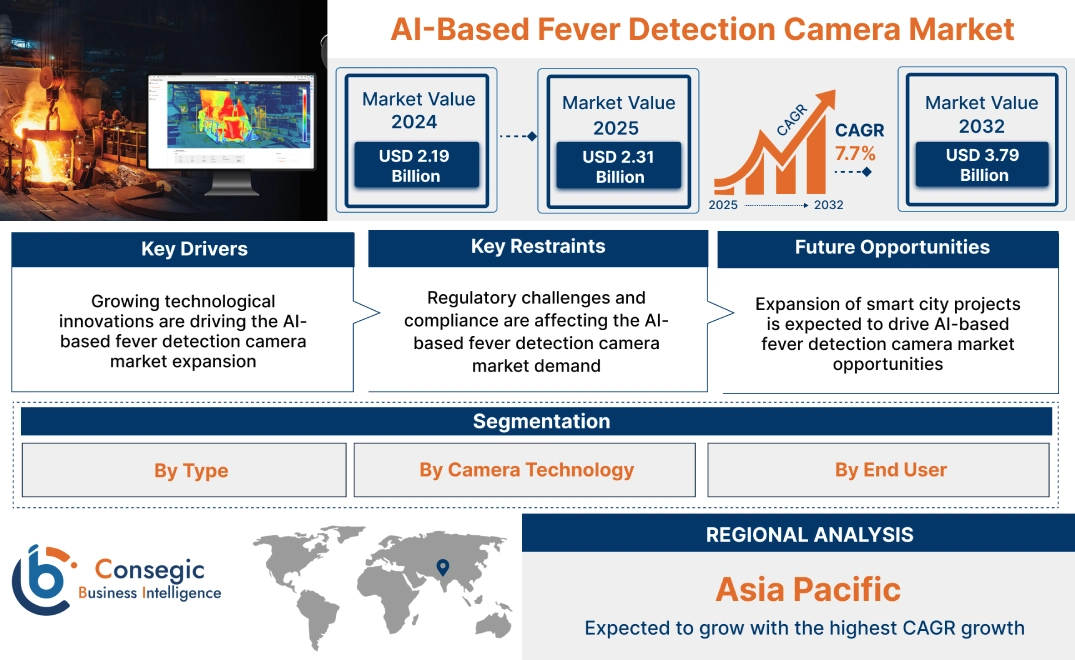- Summary
- Table Of Content
- Methodology
AI-Based Fever Detection Camera Market Size:
AI-Based Fever Detection Camera Market Size is estimated to reach over USD 3.79 Billion by 2032 from a value of USD 2.19 Billion in 2024 and is projected to grow by USD 2.31 Billion in 2025, growing at a CAGR of 7.7% from 2025 to 2032.
AI-Based Fever Detection Camera Market Scope & Overview:
An AI-based fever detection camera is a device that uses thermal imaging and artificial intelligence to automatically detect elevated body temperatures in individuals. These cameras are often used in public spaces, such as airports and hospitals to identify people who may have a fever. They utilize AI algorithms to analyze thermal images and quickly identify potential cases of fever, often without the need for direct contact with individuals.
Key Drivers:
Growing technological innovations are driving the AI-based fever detection camera market expansion
The recent progress in artificial intelligence (AI) is improving how accurately fever detection cameras work, which is very important for managing public health. Traditional thermal cameras often give incorrect readings as they are affected by things like the surrounding temperature and moisture in the air. However, AI-powered systems use complex calculations to examine information in real time. This allows users to get exact temperature measurements even when conditions are not ideal.
Further, deep learning techniques have transformed how images are analyzed for fever detection. By training AI models on extensive collections of data, these systems can identify subtle patterns and unusual readings that human reviewers might miss. This is particularly important in busy places such as airports and hospitals, where quickly finding individuals with high temperatures can be crucial to stop infectious diseases from spreading.
- For instance, FLIR Systems' new AI-powered fever detection camera, the FLIR A65, utilizes thermal imaging along with machine learning algorithms to accurately identify individuals with elevated temperatures in real time. This camera is designed for easy integration with existing systems and delivers temperature data in a standardized format through its compatibility with GenICam software.
Thus, according to the AI-based fever detection camera market analysis, the growing technological advancements are driving the AI-based fever detection camera market size.
Key Restraints:
Regulatory challenges and compliance are affecting the AI-based fever detection camera market demand
The market is navigating a complex set of regulations that greatly affect its development and how well it functions. As these sophisticated imaging systems become more common in public health, it is crucial to follow different regulatory rules. Different parts of the world have their own rules about how accurate, safe, and private these cameras need to be, which makes it stricter to create and use them. For instance, the European Union’s General Data Protection Regulation (GDPR) has strict rules about protecting personal data, forcing manufacturers to use strong methods to make sure data cannot be linked back to individuals. Thus, the above analysis depicts that the aforementioned factors would further impact on AI-based fever detection camera market size.
Future Opportunities :
Expansion of smart city projects is expected to drive AI-based fever detection camera market opportunities
The development of smart city projects worldwide also acts as a catalyst for the market. Governments and municipalities are increasingly focusing on integrating smart technologies to enhance urban living and safety. AI-based fever detection cameras are becoming an integral part of smart surveillance systems, contributing to real-time monitoring and data collection. This integration not only aids in health safety but also aligns with broader initiatives for intelligent infrastructure and public safety management. Such developments are underscored by significant investments in digital infrastructure, further fuelling the market growth.
- For instance, in April 2020, Kogniz introduced a technology designed to identify individuals who might have the deadly coronavirus. Their system uses advanced cameras and AI-powered software to detect potentially infected people before they enter a building. The AI is specifically programmed to locate individuals and then analyze temperature readings from their head to detect fever.
Thus, based on the above AI-based fever detection camera market analysis, the development of smart city projects is expected to drive the AI-based fever detection camera market opportunities.
AI-Based Fever Detection Camera Market Segmental Analysis :
By Type:
Based on type, the market is segmented into fixed cameras, portable cameras, and handheld cameras.
Trends in the type:
- The segment growth can be attributed to the growing technological advancements to enhance the detection accuracy and usability of these cameras. Manufacturers are focusing on developing better cameras with improved resolution, faster processing speeds, and improved AI algorithms to meet the increasing demand.
- Fever-detecting AI cameras are being combined with other technologies, such as access control and face recognition, to create comprehensive screening solutions. With cloud services and remote monitoring, the data from these cameras can be tracked and reported instantly. This allows businesses to effectively manage their screening processes.
- Thus, the above factors are driving the AI-based fever detection camera market demand and trends.
The fixed cameras segment accounted for the largest revenue share in the year 2024.
- Fixed cameras are extensively used in areas where constant surveillance is required, such as airports and large public spaces.
- Their installation is crucial for environments demanding continuous, real-time monitoring.
- These cameras often feature advanced detection algorithms that enhance their capacity to identify fevers in large crowds without the need for manual intervention, making them cost-effective for long-term deployment.
- Thus, based on the above analysis, these factors are further driving the AI-based fever detection camera market growth and trends.
The handheld cameras segment is anticipated to register the fastest CAGR during the forecast period.
- Handheld cameras are smaller and more portable and offer significant advantages in terms of mobility and targeted screenings.
- These devices are particularly beneficial in healthcare settings and during events where quick, on-the-spot temperature checks are necessary.
- Their portability makes them ideal for use in temporary setups or locations where permanent installation of cameras is not feasible.
- The ability to move freely and conduct precise, close-range temperature scans makes a better choice among frontline workers and security personnel.
- Thus, based on the above analysis, these trends are expected to drive the AI-based fever detection camera market share and growth during the forecast period.
By Camera Technology:
Based on camera technology, the market is segmented into thermal imaging, infrared sensors, and visible light cameras.
Trends in the camera technology:
- The growing focus on enhancing the reliability of temperature readings through more sophisticated AI algorithms and better sensor technology is driving the segment.
- There is a rising trend towards miniaturization and increased processing power, which enables the development of compact and efficient fever detection cameras. These innovations are paving the way for broader adoption across various industry verticals, as they offer improved performance and ease of integration into existing infrastructures.
- These factors are anticipated to further drive the AI-based fever detection camera market trends.
The thermal imaging segment accounted for the largest revenue share of 52.88% in the year 2024 and it is expected to register the highest CAGR during the forecast period.
- Thermal imaging systems operate by detecting infrared radiation emitted by objects and converting it into visible images, allowing for non-contact temperature measurement and visualization of heat patterns.
- Technological advancements, including the development of high-resolution sensors and integration with artificial intelligence (AI) for advanced analytics, continue to drive innovation within the segment. These innovations improve thermal imaging system capabilities, enhancing their accuracy, reliability, and versatility across diverse applications.
- Manufacturers are focusing on reducing the size and weight of thermal cameras without compromising on performance and image quality. This development has led to the creation of lightweight and ruggedized systems capable of withstanding harsh environmental conditions while delivering reliable thermal imaging capabilities in real-time.
- For instance, Marlowe Fire & Security Limited’s thermal imaging camera provide fever screening by detecting elevating elevated body temperatures in large group of people, with accuracy up to ±0.3°C. These cameras display visual pictures along with temperature readings shown on a scale. They also have audible alerts that can be programmed to sound when a specific temperature is reached.
- Therefore, these factors would further supplement the AI-based fever detection camera market
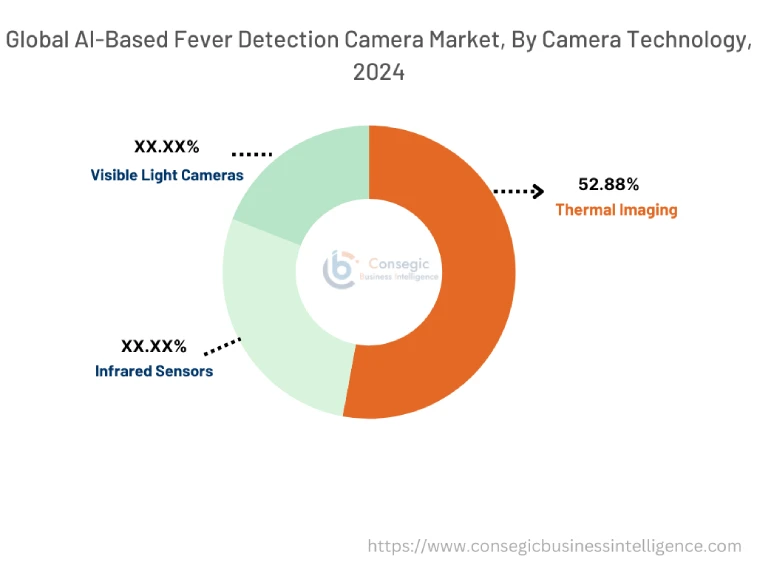
By End User:
Based on end user, the market is segmented into transportation, BFSI, education, government & defense, healthcare, manufacturing facilities, retail, food & beverages, sports, and others.
Trends in the end user:
- The implementation of fever detection cameras at airports aids in the swift and efficient screening of passengers, thereby minimizing the risk of disease transmission and ensuring a smooth travel experience.
- Industrial applications are also expanding as companies recognize the importance of maintaining a healthy workforce. In manufacturing plants and construction sites, fever detection cameras are utilized to screen employees before entering the workplace, helping to minimize disruptions caused by illness outbreaks. The use of these cameras in industrial environments not only ensures compliance with safety standards but also contributes to maintaining productivity and worker optimism.
The healthcare segment accounted for the largest revenue share in the year 2024.
- Hospitals, clinics, and medical centers leverage fever detection cameras to quickly identify potentially contagious individuals and take appropriate measures, thus, safeguarding vulnerable populations and ensuring compliance with health regulations.
- The ability to conduct non-intrusive screenings complements existing medical protocols, enhancing overall operational efficiency and patient care.
- For instance, Workswell designed MEDICAS, a thermal imaging solution for hospital and healthcare facilities. This innovative solution utilizes a high-resolution 640x512 pixel camera capable of detecting very subtle temperature variations (as small as 0.03°C). MEDICAS adheres to global standards like IEC, ISO, and GDPR, ensuring compliance and reliability. For superior accuracy and consistent performance, the system features real-time, continuous calibration using Workswell BB90 and BB200 black body calibrators.
- Thus, based on the above analysis, these factors are driving the AI-based fever detection camera market growth.
The transportation segment is anticipated to register the fastest CAGR during the forecast period.
- Within the transportation sector, AI-based fever detection cameras are pivotal in promoting safe travel experiences.
- Airports, train stations, and bus terminals utilize these systems to screen passengers efficiently, providing an additional layer of protection against contagious diseases.
- The implementation of fever detection cameras in transportation hubs is critical for maintaining operational continuity and public confidence, as these environments often see high volumes of travellers from diverse regions.
- For instance, according to Press Information Bureau, the total number of operational airports in India witnessed a substantial increase from 74 airports in 2014 to 148 airports in 2023.
- Thus, the above factors are anticipated to further drive the AI-based fever detection camera market trends during the forecast period.
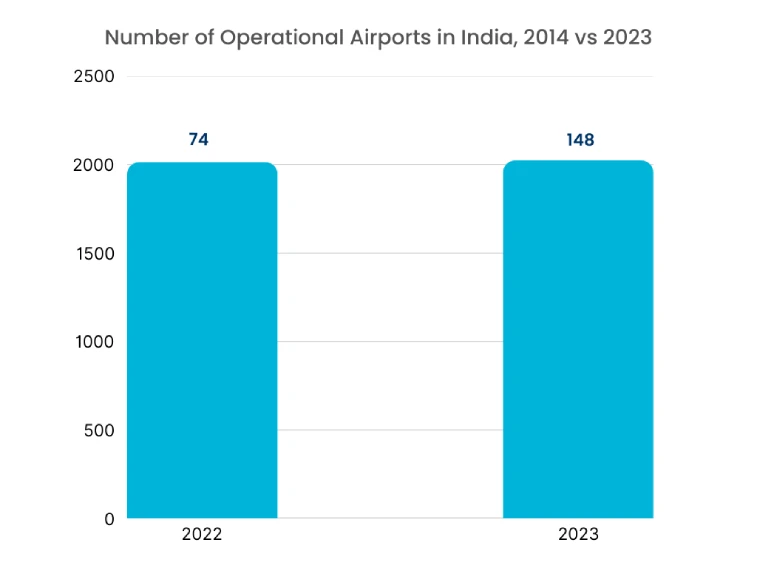
Regional Analysis:
The regions covered are North America, Europe, Asia Pacific, the Middle East and Africa, and Latin America.

Asia Pacific AI-based fever detection camera market expansion is estimated to reach over USD 0.99 billion by 2032 from a value of USD 0.55 billion in 2024 and is projected to grow by USD 0.58 billion in 2025. Out of this, the China market accounted for the maximum revenue split of 34.01%. The regional growth can be attributed to the rapid urbanization, frequent disease outbreaks, and significant investments in healthcare infrastructure. Further, governments in the region are making significant investments in smart city projects, which include incorporating fever detection cameras into their public health systems. The Indian government has installed the cameras in high-traffic zones to track temperatures and control the spread of contagious illnesses. This strategy reflects a wider pattern of developing nations utilizing technology to strengthen their public health efforts. These factors would further drive the regional AI-based fever detection camera market during the forecast period.
- For instance, Rajiv Gandhi International Airport (RGIA), Hyderabad, India implemented a fever detection camera for mass fever screening to check the body temperature of passengers. This new thermal scanner is installed on the ceiling and can simultaneously scan, identify, and track individuals with elevated skin temperatures. The above factors are driving the market in the region.
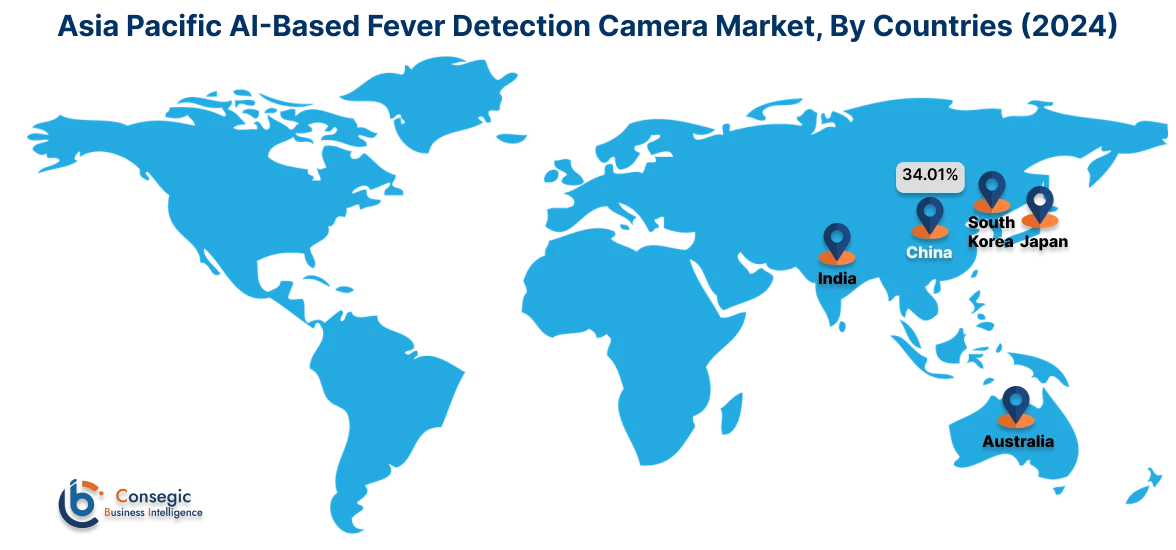
North America market is estimated to reach over USD 1.32 billion by 2032 from a value of USD 0.77 billion in 2024 and is projected to grow by USD 0.81 billion in 2025. North America is witnessing significant technological progress, including the integration of advanced algorithms and machine learning to improve the accuracy and efficiency of temperature screening. Further, the region has strong technological infrastructure and substantial research, and development investments, which contribute to its significant position in the market. Further, the utilization of AI-based fever detection cameras became particularly prominent during the COVID-19 pandemic, highlighting their essential role in mitigating contagious diseases. Beyond pandemic-related uses, the demand is propelled by the continuous mandates on health and safety regulations within crowded and high-traffic areas. These factors would further drive the regional market.
- For instance, the Los Angeles International Airport in the U.S. launched Terminal Wellness Project. Under this project, the airport authorities have deployed thermal camera technology, which helps in identifying travellers with a rising body temperature.
According to the analysis, the AI-based fever detection camera industry in Europe is projected to witness significant development during the forecast period. The region's advanced technology infrastructure and stringent health regulations support the integration of these systems in various sectors. Further, the European Union's focus on digital healthcare is encouraging collaborations between technology firms and healthcare organizations, leading to more effective fever detection systems. In Germany, hospitals are implementing AI-powered cameras to improve patient flow and rapidly detect potential fever cases, ultimately enhancing the quality of healthcare services.
Additionally, Latin American regions are witnessing increasing adoption driven by industrial growth, infrastructure projects, and rising awareness of the benefits of thermal imaging in various applications. As these economies continue to develop and prioritize modernization in security and healthcare sectors, the demand for fever detection systems is expected to grow significantly. Further, in the Middle East and Africa, countries are deploying AI-powered cameras in heavily populated areas to monitor public health. International organizations are supporting initiatives to strengthen the region's ability to handle health emergencies, which is expected to increase the use of fever detection systems.
Top Key Players and Market Share Insights:
The global AI-based fever detection camera market is highly competitive with major players providing solutions to the national and international markets. Key players are adopting several strategies in research and development (R&D), product innovation, and end-user launches to hold a strong position in the market. Key players in the AI-based fever detection camera industry include-
- Altoros (U.S.)
- AnyConnect (Singapore)
- Megvii (China)
- Honeywell (U.S.)
- Teledyne FLIR LLC (U.S.)
- Texas Instruments (U.S.)
- Bosch Security Systems (Germany)
- Wuhan Guide Infrared (China)
- Dahua Technology (China)
- Zebra Technologies (U.S.)
AI-Based Fever Detection Camera Market Ecosystem:
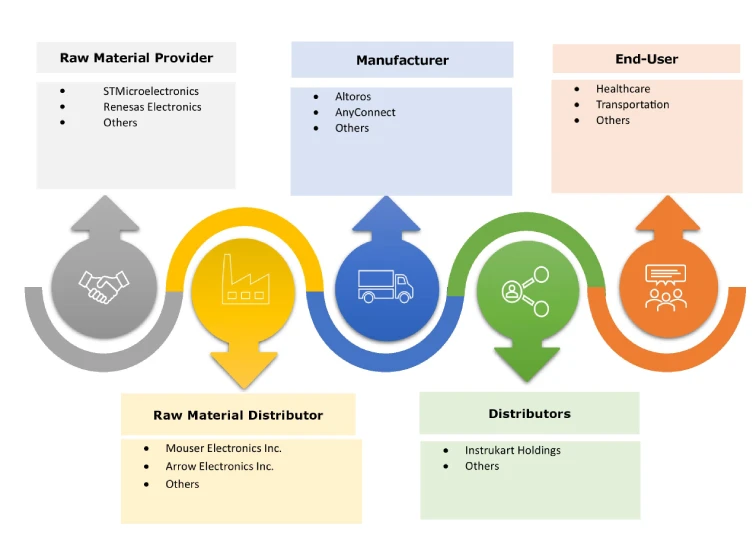
Recent Industry Developments :
Partnership:
- In May 2022, the Asian Development Bank announced partnership with UNICEF, to deploy 61 new thermal scanners for screening of passengers at Indian ports and airports. This involves screening people as they leave an area and/or placing restrictions on individuals from affected areas.
AI-Based Fever Detection Camera Market Report Insights :
| Report Attributes | Report Details |
| Study Timeline | 2019-2032 |
| Market Size in 2032 | USD 3.79 Billion |
| CAGR (2025-2032) | 7.7% |
| By Type |
|
| By Component |
|
| By End-User |
|
| By Region |
|
| Key Players |
|
| North America | U.S. Canada Mexico |
| Europe | U.K. Germany France Spain Italy Russia Benelux Rest of Europe |
| APAC | China South Korea Japan India Australia ASEAN Rest of Asia-Pacific |
| Middle East and Africa | GCC Turkey South Africa Rest of MEA |
| LATAM | Brazil Argentina Chile Rest of LATAM |
| Report Coverage |
|
Key Questions Answered in the Report
How big is the AI-Based Fever Detection Camera Market? +
AI-Based Fever Detection Camera market size is estimated to reach over USD 3.79 Billion by 2032 from a value of USD 2.19 Billion in 2024 and is projected to grow by USD 2.31 Billion in 2025, growing at a CAGR of 7.7% from 2025 to 2032.
Which is the fastest-growing region in the AI-Based Fever Detection Camera Market? +
Asia-Pacific is the region experiencing the most rapid growth in the market.
What specific segmentation details are covered in the AI-Based Fever Detection Camera report? +
The AI-based fever detection camera report includes specific segmentation details for type, camera technology, end user, and region.
Who are the major players in the AI-Based Fever Detection Camera Market? +
The key participants in the market are Altoros (U.S.), AnyConnect (Singapore), Megvii (China), Honeywell (U.S.), Teledyne FLIR LLC (U.S.), Texas Instruments (U.S.), Bosch Security Systems (Germany), Wuhan Guide Infrared (China), Dahua Technology (China), Zebra Technologies (U.S.), and others.
